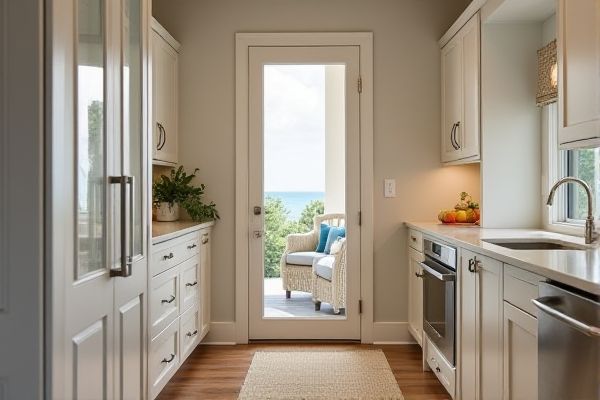
Glass pantry doors offer a stylish, modern look that allows you to showcase neatly organized items, enhancing your kitchen's brightness and openness. Discover the pros and cons of both glass and solid pantry doors to decide which option best suits your storage needs and aesthetic preferences.
Table of Comparison
| Feature | Glass Pantry Doors | Solid Pantry Doors |
|---|---|---|
| Visibility | Transparent or translucent; showcases pantry contents | Opaque; hides pantry contents |
| Style | Modern, sleek, enhances kitchen aesthetics | Classic, traditional, versatile design |
| Maintenance | Requires regular cleaning to remove fingerprints and smudges | Low maintenance; easy to clean |
| Durability | Fragile; prone to cracks and breaks | Highly durable and sturdy |
| Privacy | Low; pantry contents are visible | High; conceals pantry contents |
| Light Transmission | Allows natural or artificial light to pass through | Blocks light completely |
| Cost | Generally higher due to materials and installation | Typically more affordable |
Introduction to Glass vs. Solid Pantry Doors
Glass pantry doors offer a transparent, elegant look that allows easy visibility of contents, enhancing kitchen aesthetics and functionality. Solid pantry doors provide superior privacy and a sleek, uniform appearance while effectively concealing contents and maintaining a consistent style. Choosing between glass and solid doors depends on preferences for visibility, design, and maintenance requirements in kitchen storage solutions.
Aesthetic Appeal: Transparency vs. Privacy
Glass pantry doors offer a sleek, modern aesthetic by showcasing your organized shelves and adding visual depth to your kitchen. Solid pantry doors provide full privacy, concealing the contents and creating a clean, minimalist look that can complement various design styles. Your choice depends on whether you prioritize transparency to display your pantry or prefer the discreet elegance of a closed, solid door.
Durability and Maintenance
Glass pantry doors offer a sleek look but require frequent cleaning to maintain clarity since fingerprints and smudges are easily visible. Solid pantry doors provide superior durability, resisting dents and scratches, and typically need less upkeep over time. Your choice should consider the balance between aesthetic appeal and practical maintenance demands for your space.
Light Flow and Brightness
Glass pantry doors allow natural light to flow seamlessly between rooms, enhancing overall brightness and creating an open, airy atmosphere. This transparency helps visually expand small kitchens and makes pantry contents easily visible, improving functionality. In contrast, solid pantry doors block light, resulting in darker spaces that may feel confined but offer greater privacy and concealment of pantry contents.
Storage Visibility and Organization
Glass pantry doors enhance storage visibility by allowing you to easily see contents without opening the door, promoting better organization and quick access to items. Solid pantry doors conceal clutter, creating a cleaner look but requiring you to open the door to check inventory, which can slow down retrieval. Your choice affects how efficiently you manage pantry items and maintain an orderly kitchen space.
Energy Efficiency and Insulation
Glass pantry doors generally offer less energy efficiency and insulation compared to solid pantry doors due to their higher thermal conductivity, allowing more heat transfer and potential temperature fluctuations. Solid pantry doors provide superior insulation by minimizing heat loss and maintaining consistent interior temperatures, which can contribute to lower energy costs and enhanced food preservation. For optimal energy efficiency, options like double-pane or insulated glass doors can partially offset the insulation gap between glass and solid door materials.
Cost Comparison: Glass vs. Solid
Glass pantry doors generally cost more than solid doors due to the materials and installation complexity, with average prices ranging from $200 to $600 per door compared to $100 to $300 for solid wood options. Tempered or frosted glass panels increase durability and aesthetic appeal but add to the expense, whereas solid doors are typically cheaper, easier to install, and require less maintenance. Budget considerations often lead homeowners to choose solid doors for practicality while glass doors are favored for enhancing kitchen design and allowing visibility of pantry contents.
Customization and Design Options
Glass pantry doors offer extensive customization with various glass types, such as frosted, clear, or textured, allowing homeowners to tailor transparency and style to fit modern or traditional kitchens. Solid pantry doors provide a broad range of materials, including wood, MDF, and laminate, enabling customization in stain, paint color, and panel designs for a more classic and durable look. Both options support customizable hardware like handles and hinges, enhancing design flexibility to match specific kitchen aesthetics and functional preferences.
Safety and Security Considerations
Glass pantry doors, especially those made from tempered or laminated glass, offer enhanced safety by resisting shattering into sharp pieces, but they remain more vulnerable to impact damage compared to solid doors. Solid pantry doors provide superior security by completely concealing contents and offering stronger resistance against forced entry, making them ideal for homes requiring higher privacy and protection. Choosing between glass and solid pantry doors involves balancing aesthetic appeal with the level of safety and security appropriate for the household.
Best Applications: Choosing the Right Pantry Door for Your Space
Glass pantry doors work best in kitchens where natural light and visual openness are desired, creating an airy and inviting atmosphere while showcasing organized shelves. Solid pantry doors offer superior privacy and noise reduction, ideal for kitchen layouts needing a clutter-free appearance or separation from adjoining rooms. Selecting the right pantry door depends on balancing aesthetics with functionality, considering factors such as kitchen size, lighting, and storage visibility preferences.
 homyna.com
homyna.com